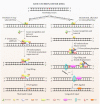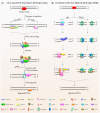DNA Damage-Induced Neurodegeneration in Accelerated Ageing and Alzheimer's Disease
- PMID: 34201700
- PMCID: PMC8268089
- DOI: 10.3390/ijms22136748
DNA Damage-Induced Neurodegeneration in Accelerated Ageing and Alzheimer's Disease
Abstract
DNA repair ensures genomic stability to achieve healthy ageing, including cognitive maintenance. Mutations on genes encoding key DNA repair proteins can lead to diseases with accelerated ageing phenotypes. Some of these diseases are xeroderma pigmentosum group A (XPA, caused by mutation of XPA), Cockayne syndrome group A and group B (CSA, CSB, and are caused by mutations of CSA and CSB, respectively), ataxia-telangiectasia (A-T, caused by mutation of ATM), and Werner syndrome (WS, with most cases caused by mutations in WRN). Except for WS, a common trait of the aforementioned progerias is neurodegeneration. Evidence from studies using animal models and patient tissues suggests that the associated DNA repair deficiencies lead to depletion of cellular nicotinamide adenine dinucleotide (NAD+), resulting in impaired mitophagy, accumulation of damaged mitochondria, metabolic derailment, energy deprivation, and finally leading to neuronal dysfunction and loss. Intriguingly, these features are also observed in Alzheimer's disease (AD), the most common type of dementia affecting more than 50 million individuals worldwide. Further studies on the mechanisms of the DNA repair deficient premature ageing diseases will help to unveil the mystery of ageing and may provide novel therapeutic strategies for AD.
Keywords: Alzheimer’s disease (AD); DNA damage; DNA repair; age-related disease.
Conflict of interest statement
E.F.F. has CRADA arrangement with ChromaDex, and is consultant to Aladdin Healthcare Technologies, Vancouver Dementia Prevention Centre, and Intellectual Labs.
Figures




Similar articles
-
Crosstalk among DNA Damage, Mitochondrial Dysfunction, Impaired Mitophagy, Stem Cell Attrition, and Senescence in the Accelerated Ageing Disorder Werner Syndrome.Cytogenet Genome Res. 2021;161(6-7):297-304. doi: 10.1159/000516386. Epub 2021 Aug 25. Cytogenet Genome Res. 2021. PMID: 34433164 Free PMC article. Review.
-
DNA repair deficiency in neurodegeneration.Prog Neurobiol. 2011 Jul;94(2):166-200. doi: 10.1016/j.pneurobio.2011.04.013. Epub 2011 Apr 30. Prog Neurobiol. 2011. PMID: 21550379 Free PMC article. Review.
-
Neurodegeneration in accelerated aging.Dan Med J. 2016 Nov;63(11):B5308. Dan Med J. 2016. PMID: 27808039 Review.
-
Mutations in Cockayne Syndrome-Associated Genes (Csa and Csb) Predispose to Cisplatin-Induced Hearing Loss in Mice.J Neurosci. 2016 Apr 27;36(17):4758-70. doi: 10.1523/JNEUROSCI.3890-15.2016. J Neurosci. 2016. PMID: 27122034 Free PMC article.
-
Contribution of defective mitophagy to the neurodegeneration in DNA repair-deficient disorders.Autophagy. 2014 Aug;10(8):1468-9. doi: 10.4161/auto.29321. Epub 2014 Jun 12. Autophagy. 2014. PMID: 24991831 Free PMC article.
Cited by
-
AI-DrugNet: A network-based deep learning model for drug repurposing and combination therapy in neurological disorders.Comput Struct Biotechnol J. 2023 Feb 8;21:1533-1542. doi: 10.1016/j.csbj.2023.02.004. eCollection 2023. Comput Struct Biotechnol J. 2023. PMID: 36879885 Free PMC article.
-
Epithelial Cell Transformation and Senescence as Indicators of Genome Aging: Current Advances and Unanswered Questions.Int J Mol Sci. 2021 Jul 14;22(14):7544. doi: 10.3390/ijms22147544. Int J Mol Sci. 2021. PMID: 34299168 Free PMC article. Review.
-
Death Induced by Survival gene Elimination (DISE) correlates with neurotoxicity in Alzheimer's disease and aging.Nat Commun. 2024 Jan 18;15(1):264. doi: 10.1038/s41467-023-44465-8. Nat Commun. 2024. PMID: 38238311 Free PMC article.
-
Modulation of Synaptic Plasticity Genes Associated to DNA Damage in a Model of Huntington's Disease.Neurochem Res. 2023 Jul;48(7):2093-2103. doi: 10.1007/s11064-023-03889-w. Epub 2023 Feb 15. Neurochem Res. 2023. PMID: 36790580
-
Alzheimer's disease, aging, and cannabidiol treatment: a promising path to promote brain health and delay aging.Mol Biol Rep. 2024 Jan 16;51(1):121. doi: 10.1007/s11033-023-09162-1. Mol Biol Rep. 2024. PMID: 38227160 Review.
References
Publication types
MeSH terms
Grants and funding
LinkOut - more resources
Full Text Sources
Medical
Research Materials
Miscellaneous

